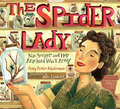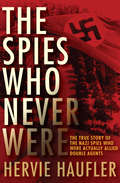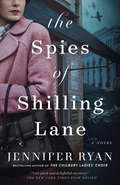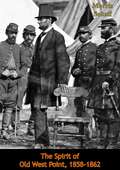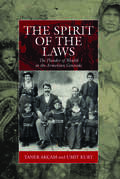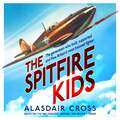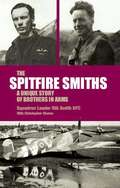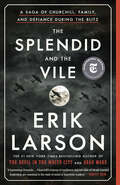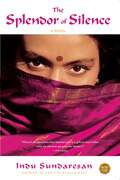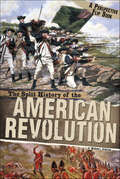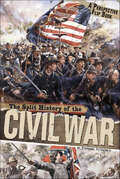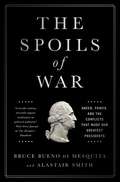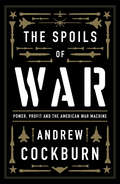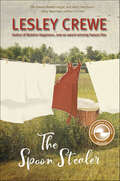- Table View
- List View
The Spider Covenant
by Brian KleinOn 10 August 1944, with Germany on the verge of a crushing and humiliating defeat, Heinrich Himmler, the second most powerful Nazi and head of the notorious SS, holds a clandestine meeting in Strasbourg, with a handful of elite industrialists and bankers.A covert organisation is born, codenamed 'Die Spinne' - The Spider. The network is tasked with helping senior SS officers escape the clutches of advancing allied forces. New identities are created, bankrolled by illicit funds, allowing notorious criminals to begin new lives in Europe and South America. Many of them land key roles in the worlds of politics, banking and industry. Decades later, they're able to pass on a privileged and influential birth right to their descendants.Himmler's secret lovechild, Amelie, is also spirited out of Germany by 'Die ,armed with a Nazi nest egg of fifty million dollars. Eighty years on, Amelie's adopted son becomes the head of the Spider network, which has evolved, survived and prospered over the decades under a cloak of secrecy.Employing a level of AI technology years ahead of anything currently known, the Spider network operates a secret facility based in Strasbourg, capable of creating undetectable Deepfakes of their own extremist politicians: perfect avatars, capable of conducting live interviews on a video stream with any news outlet in the world. The computer 'brain' of the Deepfakes is linked to state-of-the-art AI machines, programmed to create the perfect politician, spouting extreme right-wing rhetoric, aimed at winning over the masses. At a time of world disorder, with bitter wars across and the Middle East, the leaders of the Spider network look to seize their opportunity of grabbing control of the levers of political power.
The Spider Covenant (The Reich Trilogy)
by Brian KleinOn 10 August 1944, with Germany on the verge of a crushing and humiliating defeat, Heinrich Himmler, the second most powerful Nazi and head of the notorious SS, holds a clandestine meeting in Strasbourg, with a handful of elite industrialists and bankers.A covert organisation is born, codenamed 'Die Spinne' - The Spider. The network is tasked with helping senior SS officers escape the clutches of advancing allied forces. New identities are created, bankrolled by illicit funds, allowing notorious criminals to begin new lives in Europe and South America. Many of them land key roles in the worlds of politics, banking and industry. Decades later, they're able to pass on a privileged and influential birth right to their descendants.Himmler's secret lovechild, Amelie, is also spirited out of Germany by 'Die ,armed with a Nazi nest egg of fifty million dollars. Eighty years on, Amelie's adopted son becomes the head of the Spider network, which has evolved, survived and prospered over the decades under a cloak of secrecy.Employing a level of AI technology years ahead of anything currently known, the Spider network operates a secret facility based in Strasbourg, capable of creating undetectable Deepfakes of their own extremist politicians: perfect avatars, capable of conducting live interviews on a video stream with any news outlet in the world. The computer 'brain' of the Deepfakes is linked to state-of-the-art AI machines, programmed to create the perfect politician, spouting extreme right-wing rhetoric, aimed at winning over the masses. At a time of world disorder, with bitter wars across and the Middle East, the leaders of the Spider network look to seize their opportunity of grabbing control of the levers of political power.
The Spider Lady: Nan Songer and her Arachnid World War II Army
by Penny Parker KlostermannPerfect for kids who are fascinated by insects and American history, here is the story of Nan Songer, a little-known hero of World War II, who collected and bred spiders in her home and found new ways to use their silk to help the United States win the war.Venomous spiders, delicate silk, and science experiments filled Nan Songer&’s days and nights—her home in California overflowed with many-legged critters. With inspiration from a friend, Nan began to study how spider silk could be harvested. The finely woven material spiders used to create webs was much stronger than it looked, and Nan was eager to unlock its potential and hopefully help her country at the same time. At the height of WWII, she studied different spiders before landing on the poisonous black widow as the perfect spider to experiment with. Their strong silk could be used for crosshairs on rifles, which Nan used to fill massive orders for the US military. Despite the danger posed by black widows, Nan wasn&’t deterred—she wanted to play her part. Using a device she built for extracting silk, Nan humanely used it on the deadly spiders to get both extra fine and super heavy silk.
The Spider Web, The Romance Of A Flying-Boat War Flight [Illustrated Edition]
by Anon, “P.I.X”"War at sea-war in the air--This is an account of the early days, during the Great War, of the service that became the Fleet Air Arm. It did not take long after hostilities commenced for the Royal Navy to appreciate the potential of an 'air force' both as an eye in the sky and as an effective method of countering enemy surface vessels and most especially German submarine activity. Endurance, speed and surprise were the essential components of the sea-plane and flying boat war. Appearing suddenly out of the sun, a surface cruising U-Boat had little time to dive to safety before destruction rained down upon it. This book contains may gripping incidents of U-Boat hunting in the 'Spider Web', a great tract of the North Sea which was the Navy flyer's patrol area and battlefield. This was a hard war, fraught with dangers from mechanical breakdowns, attacks from enemy aircraft, lethal weather and anti-aircraft fire among its many perils. A riveting account of the sea and early aviation warfare."-Leonaur Print version.Author -- Anon, "P.I.X"Text taken, whole and complete, from the edition published in Edinburgh, W. Blackwood and sons, 1919.Original Page Count - x and 278 pages.Illustrations -- 20 maps and Illustrations.
The Spies Who Never Were: The True Story of the Nazi Spies Who Were Actually Allied Double Agents
by Hervie HauflerThe thrilling true story of the daring double agents who thwarted Hitler&’s spy machine in Britain and turned the tide of World War II. After the fall of France in the mid-1940s, Adolf Hitler faced a British Empire that refused to negotiate for peace. With total war looming, he ordered the Abwehr, Germany&’s defense and intelligence organization, to carry out Operation Lena—a program to place information-gathering spies within Britain. Quickly, a network of secret agents spread within the United Kingdom and across the British Empire. A master of disguises, a professional safecracker, a scrubwoman, a diplomat&’s daughter—they all reported news of the Allied defenses and strategies back to their German spymasters. One Yugoslav playboy codenamed &“Tricycle&” infiltrated the highest echelon of British society and is said to have been one of Ian Fleming&’s models for James Bond. The stunning truth, though, was that every last one of these German spies had been captured and turned by the British. As double agents, they sent a canny mix of truth and misinformation back to Hitler, all carefully controlled by the Allies. As one British report put it: &“By means of the double agent system, we actually ran and controlled the German espionage system in this country.&” In The Spies Who Never Were, World War II veteran cryptographer Hervie Haufler reveals the real stories of these double agents and their deceptions. This &“fascinating account&” lays out both the worldwide machinations and the personal clashes that went into the greatest deception in the history of warfare (Booklist).
The Spies of Shilling Lane: A Novel
by Jennifer RyanFrom the bestselling author of The Chilbury Ladies’ Choir comes a thrilling new WWII story about a village busybody—the mighty Mrs. Braithwaite—who resolves to find, and then rescue, her missing daughter Mrs. Braithwaite, self-appointed queen of her English village, finds herself dethroned, despised, and dismissed following her husband’s selfish divorce petition. Never deterred, the threat of a family secret being revealed sets her hot-foot to London to find the only person she has left—her clever daughter Betty, who took work there at the first rumbles of war. But when she arrives, Betty’s landlord, the timid Mr. Norris, informs her that Betty hasn’t been home in days--with the chaos of the bombs, there’s no telling what might have befallen her. Aghast, Mrs. Braithwaite sets her bullish determination to the task of finding her only daughter. Storming into the London Blitz, Mrs. Braithwaite drags the reluctant Mr. Norris along as an unwitting sidekick as they piece together Betty’s unexpectedly chaotic life. As she is thrown into the midst of danger and death, Mrs. Braithwaite is forced to rethink her old-fashioned notions of status, class, and reputation, and to reconsider the question that’s been puzzling her since her world overturned: How do you measure the success of your life? Readers will be charmed by the unforgettable Mrs. Braithwaite and her plucky, ruthless optimism, and find in The Spies of Shilling Lane a novel with surprising twists and turns, quiet humor, and a poignant examination of mothers and daughters and the secrets we keep.
The Spike
by Arnaud De Borchgrave Robert Moss[From the back cover] THE SECRET HISTORY OF PUR TIMES! From the jungles of Southeast Asia to the terrorist lairs of Hamburg and Rome. From high society orgies to the discovery of the Russian "mole" who burrowed his way to the peaks of power in America, THE SPIKE traces through international political intrigue with shattering power. Written by the only two insiders who could tell the story, this strikingly authentic thriller unveils the KGB's sinister Directorate A and its "disinformation" conspiracy--a Red plot to turn the Western media into an ' unwitting Communist pawn in the Soviet drive for global supremacy. THE SPIKE is the acclaimed bestselling superthriller of today-but it may be the frightening reality of tomorrow.
The Spirit of Old West Point, 1858-1862
by Morris SchaffThe author provides an autobiographical account of his time at the United States Military Academy at West Point at the outbreak of the American Civil War.Morris Schaff (December 28, 1840 – October 19, 1929) was an American military officer and historian. A native of Etna Township, Ohio, he wrote several books relating to U.S. Civil War history and the history of Etna and Kirkersville, in Licking County.Schaff served in multiple battles and campaigns during the U.S. Civil War, including the Rappahannock Campaign and the Richmond Campaign. He served under several well-known U.S. generals during the Civil War: Major General Gouverneur Warren, General Joseph Hooker, General George Meade, and General Ulysses S. Grant. His wartime experiences greatly influenced the authorship of his 20th century books and articles. Schaff resigned from the Army on December 31, 1871. He later became known as General Schaff because he was appointed Brigadier General of the Massachusetts Militia in 1880.
The Spirit of the Laws: The Plunder of Wealth in the Armenian Genocide
by Taner Akçam Umit KurtPertinent to contemporary demands for reparations from Turkey is the relationship between law and property in connection with the Armenian Genocide. This book examines the confiscation of Armenian properties during the genocide and subsequent attempts to retain seized Armenian wealth. Through the close analysis of laws and treaties, it reveals that decrees issued during the genocide constitute central pillars of the Turkish system of property rights, retaining their legal validity, and although Turkey has acceded through international agreements to return Armenian properties, it continues to refuse to do so. The book demonstrates that genocides do not depend on the abolition of the legal system and elimination of rights, but that, on the contrary, the perpetrators of genocide manipulate the legal system to facilitate their plans.
The Spitfire Kids: The generation who built, supported and flew Britain's most beloved fighter
by Alasdair Cross BBC Worldwide'An inspirational read celebrating the incredible young people who gave so much for this iconic British aircraft'. John Nichol, bestselling author of Spitfire: A Very British Love StoryDespite the many films and television programmes over the decades since the end of the Second World War that portrays our allied heroes as grown-up men and women, the Battle of Britain was in the main actually fought and won by teenagers. The average age of an RAF fighter pilot was just twenty years old. Many of the men and women who designed and built their planes were even younger. Based on the hit BBC World Service podcast Spitfire: The People's Story, we use contemporary diaries and memoirs, many of them previously unpublished, to tell the story of the Spitfire through the voices of the teenagers who risked everything to design, build and fly her. This isn't a story of stiff-upper lips, stoical moustaches and aerial heroics; it's a story of love and loss, a story of young people tested to the very limits of their endurance. Young people who won a battle that turned a war.
The Spitfire Kids: The generation who built, supported and flew Britain's most beloved fighter
by Alasdair Cross BBC WorldwideTHE SUNDAY TIMES BESTSELLER'An inspirational read celebrating the incredible young people who gave so much for this iconic British aircraft'. John Nichol, bestselling author of Spitfire: A Very British Love StoryDespite the many films and television programmes over the decades since the end of the Second World War that portrays our allied heroes as grown-up men and women, the Battle of Britain was in the main actually fought and won by teenagers. The average age of an RAF fighter pilot was just twenty years old. Many of the men and women who designed and built their planes were even younger. Based on the hit BBC World Service podcast Spitfire: The People's Story, we use contemporary diaries and memoirs, many of them previously unpublished, to tell the story of the Spitfire through the voices of the teenagers who risked everything to design, build and fly her. This isn't a story of stiff-upper lips, stoical moustaches and aerial heroics; it's a story of love and loss, a story of young people tested to the very limits of their endurance. Young people who won a battle that turned a war.
The Spitfire Kids: The generation who built, supported and flew Britain's most beloved fighter
by Alasdair Cross BBC Worldwide'An inspirational read celebrating the incredible young people who gave so much for this iconic British aircraft'. John Nichol, bestselling author of Spitfire: A Very British Love StoryDespite the many films and television programmes over the decades since the end of the Second World War that portrays our allied heroes as grown-up men and women, the Battle of Britain was in the main actually fought and won by teenagers. The average age of an RAF fighter pilot was just twenty years old. Many of the men and women who designed and built their planes were even younger. Based on the hit BBC Radio podcast Spitfire: The People's Story, we use contemporary diaries and memoirs, many of them previously unpublished, to tell the story of the Spitfire through the voices of the teenagers who risked everything to design, build and fly her. This isn't a story of stiff-upper lips, stoical moustaches and aerial heroics; it's a story of love and loss, a story of young people tested to the very limits of their endurance. Young people who won a battle that turned a war.(P)2021 Headline Publishing Group Limited
The Spitfire Smiths: A Unique Story of Brothers in Arms
by Christopher Shores Rod SmithA posthumous autobiography, culled from a partial manuscript and notes, by Canada&’s World War II fighter ace and his equally heroic brother. In late 2001 Rod Smith died tragically at his own hand, leaving behind a part-written autobiography and many notes. His friend, the historian Christopher Shores, took on the task of seeking to complete the story as nearly as possible to how he believed Rod had wished it to be. Rod and his brother Jerry both became Spitfire pilots during World War II, leaving their home in Canada only to find themselves—purely by chance—serving together in the defense of Malta during 1942. Jerry had already gained some fame as the first pilot ever to land a Spitfire on an aircraft carrier. Both showed immediate promise as fighter pilots, but by the end of that year Jerry was dead—last seen chasing a German bomber out to sea—while Rod had become an &“ace&” and would receive the D.F.C. Two years later, serving as a squadron commander in Western Europe, he claimed six Messerschmitts down within a single week, and was involved in the shooting down of the first German jet aircraft to fall to British Commonwealth fighters. He ended the war as one of Canada&’s highest scoring aces, with more than 13 victories to his credit. After the war, he qualified as both an aeronautical engineer and a barrister. His untimely death was a great loss not only to his family and friends, but to the wider world of aviation history as well. This book, containing many diary entries from each of the brothers, is a testament to them.
The Spitfire: An Icon of the Skies
by Philip Kaplan&“An amazing tribute to the people who designed, built and flew it—a comprehensive history of one of the most beautiful aircraft ever manufactured.&”—Books Monthly The magnificent Vickers Supermarine Spitfire, together with its able partner the Hawker Hurricane, saved Britain from Nazi invasion in the summer of 1940 and irrevocably changed the course of the Second World War. This book from Philip Kaplan celebrates one of history&’s most important weapons in a glorious new light. A British national icon, the Spitfire is the best-known symbol of the war years for generations of Britons. From the deep, haunting growl of its Rolls-Royce engine, to the elegant style of its elliptical wing, it is perhaps the most famous and revered combat airplane ever built. Kaplan investigates just what it is that fuels the Spitfire&’s compelling mystique. During wartime, it held an unrivaled reputation amongst Allied and Axis airmen. Today, it continues to hold aviation enthusiasts in thrall. Kaplan highlights the immeasurable contributions of Spitfire designers Reginald J. Mitchell and Joseph Smith, test pilots Jeffrey Quill, Mutt Summers and Alex Henshaw, and ace Spitfire pilots including Al Deere, Sailor Malan and Pierre Clostermann. All added to the legend of this lovely, but deadly, little fighter. &“Can be considered a &‘Potted History&’ of the Spitfire and its military and civilian service, with particular emphasis being placed on the restoration of AR213. On that basis it will probably appeal to Spitfire aficionados in particular and to aviation and war-bird enthusiasts in general.&”—NZ Crown Mines
The Splendid and the Vile: A Saga of Churchill, Family, and Defiance During the Blitz
by Erik Larson#1 NEW YORK TIMES BESTSELLER • The author of The Devil in the White City and Dead Wake delivers an intimate chronicle of Winston Churchill and London during the Blitz—an inspiring portrait of courage and leadership in a time of unprecedented crisis &“One of [Erik Larson&’s] best books yet . . . perfectly timed for the moment.&”—Time • &“A bravura performance by one of America&’s greatest storytellers.&”—NPR NAMED ONE OF THE BEST BOOKS OF THE YEAR BY The New York Times Book Review • Time • Vogue • NPR • The Washington Post • Chicago Tribune • The Globe & Mail • Fortune • Bloomberg • New York Post • The New York Public Library • Kirkus Reviews • LibraryReads • PopMattersOn Winston Churchill&’s first day as prime minister, Adolf Hitler invaded Holland and Belgium. Poland and Czechoslovakia had already fallen, and the Dunkirk evacuation was just two weeks away. For the next twelve months, Hitler would wage a relentless bombing campaign, killing 45,000 Britons. It was up to Churchill to hold his country together and persuade President Franklin Roosevelt that Britain was a worthy ally—and willing to fight to the end. In The Splendid and the Vile, Erik Larson shows, in cinematic detail, how Churchill taught the British people &“the art of being fearless.&” It is a story of political brinkmanship, but it&’s also an intimate domestic drama, set against the backdrop of Churchill&’s prime-ministerial country home, Chequers; his wartime retreat, Ditchley, where he and his entourage go when the moon is brightest and the bombing threat is highest; and of course 10 Downing Street in London. Drawing on diaries, original archival documents, and once-secret intelligence reports—some released only recently—Larson provides a new lens on London&’s darkest year through the day-to-day experience of Churchill and his family: his wife, Clementine; their youngest daughter, Mary, who chafes against her parents&’ wartime protectiveness; their son, Randolph, and his beautiful, unhappy wife, Pamela; Pamela&’s illicit lover, a dashing American emissary; and the advisers in Churchill&’s &“Secret Circle,&” to whom he turns in the hardest moments. The Splendid and the Vile takes readers out of today&’s political dysfunction and back to a time of true leadership, when, in the face of unrelenting horror, Churchill&’s eloquence, courage, and perseverance bound a country, and a family, together.
The Splendor of Silence: A Novel
by Indu SundaresanSet in India during four searing pre-monsoon days in May 1942, The Splendor of Silence is internationally bestselling author Indu Sundaresan's most unforgettable accomplishment yet, merging her Indian and American backgrounds into a heartrending tale of love and clashing cultures in a time of war. Sam Hawthorne, a twenty-five-year-old U.S. Army captain, arrives at the princely state of Rudrakot in search of his missing brother, Mike, carrying with him wounds from combat in Burma and several secrets. But Sam's mission is soon threatened by the unlikeliest of sources -- he falls hopelessly in love with Mila, daughter of the local political agent. Mila, unexpectedly attracted to Sam, nurtures a secret of her own and finds herself torn between loyalty to her family and Sam. The Splendor of Silence opens twenty-one years later with Olivia, Sam's daughter, receiving a trunk of treasures from India, along with a letter from an unknown narrator that finally fills all the silences of her childhood -- telling her the story of her parents' passionate and enduring love for each other that throws them in the path of racial prejudice, nationalist intrigue, and the explosive circumstances of a country and a society on the brink of independence from British rule. Sweeping and poignant, reminiscent of Paul Scott's Raj Quartet novels, The Splendor of Silence will draw a host of devoted new fans to this hugely gifted storyteller.
The Splintered Kingdom
by James AitchesonThe brilliant second novel in James Aitcheson's trilogy of the Norman Conquest of England.Summer, 1070. Renowned for his valor in the battle for York, Tancred a Dinant is now a lord in his own right, with knights of his own to command and a manor to call home in the turbulent Welsh borderlands. But his hard-fought gains are soon threatened, as a coalition of enemies both old and new prepares to march against King William.With English, Welsh and Viking forces gathering, and war looming, the Normans are forced to make common cause with some unlikely allies in defence of their newly conquered realm. For Tancred, meanwhile, there are also enemies closer to home: Norman barons envious of his fame, who regard him as a threat to their own power and who are only too eager to see him brought low. Amidst the turmoil, Tancred is chosen to spearhead a perilous expedition into the heart of Wales. Success will bring him glory beyond his dreams. Failure will mean the ruin of the reputation that he has worked so hard to forge. As shield-walls clash and the kingdom burns, not only is his destiny at stake, but also that of England itself.A gripping tale of battle, honor, and vengeance, The Splintered Kingdom is an epic saga of the struggle for England-and through it, the western world.
The Split History of World War II (Perspectives Flip Books)
by Simon RoseWhen World War I ended in 1918, it was called, "the war to end all wars." But it wasn't. Unsettled issues and resentments festered for the next 20 years, culminating in the outbreak of war in Europe and Asia in the 1930s. The Axis powers, led by Germany, Italy, and Japan, joined to fight the Allies, led by the U.S., the United Kingdom, and the Soviet Union. Both sides were determined to rule the world, but only one can succeed.
The Split History of the American Revolution (Perspectives Flip Books)
by Michael BurganPeople from Great Britain came to North America to start new lives in the 13 American colonies. In the beginning colonists accepted British rule without question. But by the mid-1700s, things were changing. Many colonists wanted the right to govern themselves. The British government felt as if the colonists were being ungrateful. By 1775 war between the two sides was inevitable.
The Split History of the Civil War (Perspectives Flip Books)
by Stephanie FitzgeraldIn 1861 the United States was at a crossroads. People in the Southern states believed that Northerners were trying to change their way of life. People in the North were upset that Southerners wanted to govern themselves. The issue of slavery was caught in the middle. As the events of the Civil War unfolded, each side fought for what they believed in.
The Spoils of War: 3 (Damned)
by Alan Dean FosterAfter millennia of relentless war, the union of alien races called the Weave was on the verge of winning a decisive victory - thanks to their new allies from Earth, who in a mere handful of centuries had proved masters of combat. But then the birdlike Wais scholar Lalelelang found disturbing evidence that Humans might not adapt so easily to peace - that natural Human aggression would next be turned against the Weave, unless they were once again confined to fight amongst themselves.When her field research revealed the existence of a secret group of powerfully telepathic Humans called the Core, it looked as if Lalelelang would be the first victim in a new war between Humans and their allies. But just as her fate was sealed, a lone Core commander took a chance on her intelligence and compassion, gambling the fate of Humanity on the possibility that together they could both find an alternative to a galaxy-wide bloodbath...
The Spoils of War: Greed, Power, and the Conflicts That Made Our Greatest Presidents
by Bruce Bueno de Mesquita Alastair SmithWhy are America's most beloved presidents also our most dangerous?It's striking how many of the presidents Americans venerate-Abraham Lincoln, George Washington, Franklin D. Roosevelt, and John F. Kennedy, to name a few-oversaw some of the republic's bloodiest years. Perhaps they were driven by the needs of the American people and the nation. Or maybe they were just looking out for themselves.This revealing and entertaining book puts some of America's greatest leaders under the microscope, showing how their calls for war, usually remembered as brave and noble, were in fact selfish and convenient. In each case, our presidents chose personal gain over national interest while loudly evoking justice and freedom. The result is an eye-opening retelling of American history, and a call for reforms that may make the future better.Bueno de Mesquita and Smith demonstrate in compelling fashion that wars, even bloody and noble ones, are not primarily motivated by democracy or freedom or the sanctity of human life. When our presidents risk the lives of brave young soldiers, they do it for themselves.
The Spoils of War: Power, Profit and the American War Machine
by Andrew CockburnWhy Does America Go to War?In the last decades, America has gone to war as supposed defenders of democracy. The War on Terror was waged to protect the west from the dangers of Islamists. US Solders are stationed in over 800 locations across the world to act as the righteous arbiters of the rule of law. In What The Spoils of War Andrew Cockburn brilliantly dissects the intentions behind Washington's martial appetites.The American war machine can only be understood in terms of the "private passions" and "interests" of those who control it - principally a passionate interest in money. Thus, as he witheringly reports, Washington expanded NATO to satisfy an arms manufacturer's urgent financial requirements; the U.S. Navy's Pacific fleet deployments were for years dictated by a corrupt contractor who bribed high-ranking officers with cash and prostitutes; senior marine commanders agreed to a troop surge in Afghanistan in 2017 "because it will do us good at budget time."Based on years of wide-ranging research, Cockburn lays bare the ugly reality of the largest military machine in history: squalid, and at the same time terrifyingly dangerous.
The Spook Who Sat by the Door
by Sam GreenleeThis book is both a satire of the civil rights problems in the United States in the late 60s and a serious attempt to focus on the issue of black militancy.
The Spoon Stealer
by Lesley Crewe"Born into a basket of clean sheets—ruining a perfectly good load of laundry—Emmeline never quite fit in on her family's rural Nova Scotian farm. After suffering multiple losses in the First World War, her family became so heavy with grief, toxicity, and mental illness that Emmeline felt their weight smothering her. And so, she fled across the Atlantic and built her life in England. Now she is retired and living in a small coastal town with her best friend, Vera, an excellent conversationalist. Vera is also a small white dog, and so Emmeline is making an effort to talk to more humans. When she joins a memoir-writing course at the library, her classmates don't know what to make of her. Funny, loud, and with a riveting memoir, she charms the lot. As her past unfolds for her audience, friendships form, a bonus in a rather lonely life. She even shares with them her third-biggest secret: she has liberated hundreds of spoons over her lifetime—from the local library, Cary Grant, Winston Churchill. She is a compulsive spoon stealer. When Emmeline unexpectedly inherits the farm she grew up on, she knows she needs to leave her new friends and go see the farm and what remains of her family one last time. She arrives like a tornado in their lives, an off-kilter Mary Poppins bossing everyone around and getting quite a lot wrong. But with her generosity and hard-earned wisdom, she gets an awful lot right too. A pinball ricocheting between people, offending and inspiring in equal measure, Emmeline, in her final years, believes that a spoonful—perhaps several spoonfuls—of kindness can set to rights the family so broken by loss and secrecy. The Spoon Stealer is a classic Crewe book: full of humour, family secrets, women's friendship, lovable animals, and immense heart."


